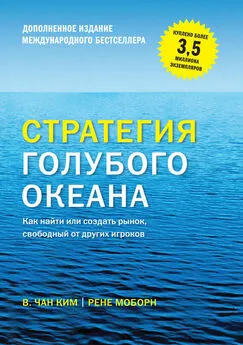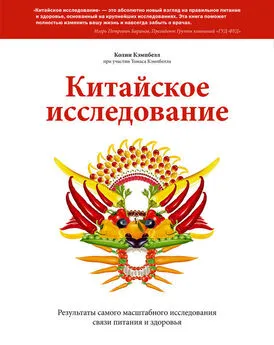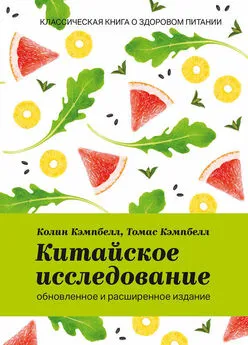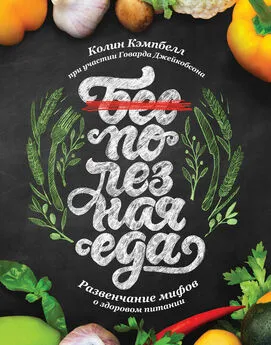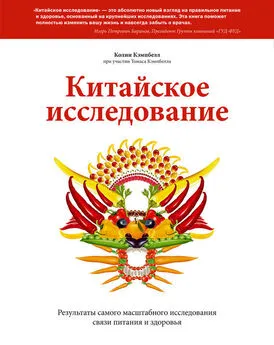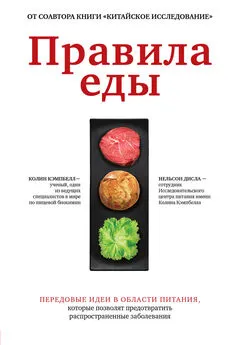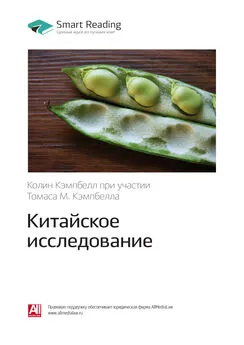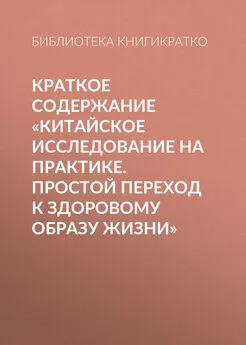Колин Кэмпбелл - Китайское исследование: обновленное и расширенное издание. Классическая книга о здоровом питании [litres]
- Название:Китайское исследование: обновленное и расширенное издание. Классическая книга о здоровом питании [litres]
- Автор:
- Жанр:
- Издательство:Литагент МИФ без БК
- Год:2018
- Город:Москва
- ISBN:978-5-00100-976-4
- Рейтинг:
- Избранное:Добавить в избранное
-
Отзывы:
-
Ваша оценка:
Колин Кэмпбелл - Китайское исследование: обновленное и расширенное издание. Классическая книга о здоровом питании [litres] краткое содержание
На русском языке публикуется впервые.
Китайское исследование: обновленное и расширенное издание. Классическая книга о здоровом питании [litres] - читать онлайн бесплатно ознакомительный отрывок
Интервал:
Закладка:
770
Westman E. C., Yancy W. S., Edman J. S., et al. “Carbohydrate Diet Program.” Am. J. Med. 113 (2002): 30–36.
771
Frassetto L. A., Todd K. M., Morris C., Jr., et al. “Worldwide incidence of hip fracture in elderly women: relation to consumption of animal and vegetable foods.” J. Gerontology 55 (2000): M585–M592.
772
Sellmeyer D. E., Stone K. L., Sebastian A., et al. “A high ratio of dietary animal to vegetable protein increases the rate of bone loss and the risk of fracture in postmenopausal women.” Am. J. Clin. Nutr. 73 (2001): 118–122.
773
Frassetto L. A., Todd K. M., Morris C., Jr., et al. “Worldwide incidence of hip fracture in elderly women: relation to consumption of animal and vegetable foods.” J. Gerontology 55 (2000): M585–M592.
774
Hegsted D. M. “Calcium and osteoporosis.” J. Nutr. 116 (1986): 2316–2319.
775
Heaney R. P. “Protein intake and bone health: the influence of belief systems on the conduct of nutritional science.” Am. J. Clin. Nutr. 73 (2001): 5–6.
776
Cummings S. R., and Black D. “Bone mass measurements and risk of fracture in Caucasian women: a review of findings for prospective studies.” Am. J. Med. 98 (Suppl 2A) (1995): 2S–24S.
777
Marshall D., Johnell O., and Wedel H. “Meta-analysis of how well measures of bone mineral density predict occurrence of osteoporotic fractures.” Brit. Med. J. 312 (1996): 1254–1259.
778
Lips P. “Epidemiology and predictors of fractures associated with osteoporosis.” Am. J. Med. 103(2A) (1997): 3S–11S.
779
Lane N. E., and Nevitt M. C. “Osteoarthritis, bone mass, and fractures: how are they related?” Arthritis Rheumatism 46 (2002): 1–4.
780
Lucas F. L., Cauley J.A., Stone R. A., et al. “Bone mineral density and risk of breast cancer: differences by family history of breast cancer.” Am. J. Epidemiol. 148 (1998): 22–29.
781
Cauley J. A., Lucas F. L., Kuller L. H., et al. “Bone mineral density and risk of breast cancer in older women: the study of osteoporotic fractures.” JAMA 276 (1996): 1404–1408.
782
Mincey B. A. “Osteoporosis in women with breast cancer.” Curr. Oncol. Rpts. 5 (2003): 53–57.
783
Riis B. J. “The role of bone loss.” Am. J. Med. 98 (Suppl 2A) (1995): 2S–29S.
784
Ho S. C. “Body measurements, bone mass, and fractures: does the East differ from the West?” Clin. Orthopaed. Related Res. 323 (1996): 75–80.
785
Aspray T. J., Prentice A., Cole T. J., et al. “Low bone mineral content is common but osteoporotic fractures are rare in elderly rural Gambian women.” J. Bone Min. Res. 11 (1996): 1019–1025.
786
Tsai K.-S. “Osteoporotic fracture rate, bone mineral density, and bone metabolism in Taiwan.” J. Formosan Med. Assoc. 96 (1997): 802–805.
787
Ho S. C. “Body measurements, bone mass, and fractures: does the East differ from the West?” Clin. Orthopaed. Related Res. 323 (1996): 75–80.
788
Wu A. H., Pike M. C., and Stram D. O. “Meta-analysis: dietary fat intake, serum estrogen levels, and the risk of breast cancer.” J. Nat. Cancer Inst. 91 (1999): 529–534.
789
Frassetto L. A., Todd K. M., Morris C., Jr., et al. “Worldwide incidence of hip fracture in elderly women: relation to consumption of animal and vegetable foods.” J. Gerontology 55 (2000): M585–M592.
790
Sellmeyer D. E., Stone K. L., Sebastian A., et al. “A high ratio of dietary animal to vegetable protein increases the rate of bone loss and the risk of fracture in postmenopausal women.” Am. J. Clin. Nutr. 73 (2001): 118–122.
791
Sellmeyer D. E., Stone K. L., Sebastian A., et al. “A high ratio of dietary animal to vegetable protein increases the rate of bone loss and the risk of fracture in postmenopausal women.” Am. J. Clin. Nutr. 73 (2001): 118–122.
792
Центр лечения мочекаменной болезни при Калифорнийском университете «Мочекаменная болезнь – индекс» / Индекс UCLA Kidney Stone Treatment Center. “Kidney Stones – Index.” март 1997 г. На сайте www.radsci.ucla.edu:8000/gu/stones/kidneystone.html.
793
Центр лечения мочекаменной болезни при Калифорнийском университете «Мочекаменная болезнь – индекс» / Индекс UCLA Kidney Stone Treatment Center. “Kidney Stones – Index.” март 1997 г. На сайте www.radsci.ucla.edu:8000/gu/stones/kidneystone.html.
794
Stamatelou K. K., Francis M. E., Jones C. A., et al. “Time trends in reported prevalence of kidney stones.” Kidney Int. 63 (2003): 1817–1823.
795
Эта генетически редкая разновидность мочекаменной болезни обусловлена неспособностью почек реабсорбировать аминокислоту цистеин.
796
Ramello A., Vitale C., and Marangella M. “Epidemiology of nephrolothiasis.” J. Nephrol. 13 (Suppl 3) (2000): S65–S70.
797
Robertson W. G., Peacock M., and Hodgkinson A. “Dietary changes and the incidence of urinary calculi in the U.K. between 1958 and 1976.” Chron. Dis. 32 (1979): 469–476.
798
Robertson W. G., Peacock M., Heyburn P. J., et al. “Risk factors in calcium stone disease of the urinary tract.” Brit. J. Urology 50 (1978): 449–454.
799
Robertson W. G. “Epidemiological risk factors in calcium stone disease.” Scand. J. Urol. Nephrol. Suppl. 53 (1980): 15–30.
800
Robertson W. G., Peacock M., Heyburn P. J., et al. “Should recurrent calcium oxalate stone formers become vegetarians?” Brit. J. Urology 51 (1979): 427–431.
801
Robertson W. G. “Epidemiological risk factors in calcium stone disease.” Scand. J. Urol. Nephrol. Suppl. 53 (1980): 15–30.
802
Robertson W. G., Peacock M., Heyburn P. J., et al. “Should recurrent calcium oxalate stone formers become vegetarians?” Brit. J. Urology 51 (1979): 427–431.
803
Эта информация была обнародована на семинаре доктора Робертсона в Торонто.
804
Robertson W. G., Peacock M., Heyburn P. J., et al. “Should recurrent calcium oxalate stone formers become vegetarians?” Brit. J. Urology 51 (1979): 427–431.
805
Robertson W. G., Peacock M., Heyburn P. J., et al. “Should recurrent calcium oxalate stone formers become vegetarians?” Brit. J. Urology 51 (1979): 427–431.
806
Robertson W. G. “Diet and calcium stones.” Miner Electrolyte Metab. 13 (1987): 228–234.
807
Cao L. C., Boeve E. R., de Bruijn W. C., et al. “A review of new concepts in renal stone research.” Scanning Microscopy 7 (1993): 1049–1065.
808
Scales C. D. J., Smith A. C., Hanley J. M., Seigal C. S., and Urologic Diseases in America Project. “Prevalence of kidney stones in the United States.” Eur. Urol. 62 (2012): 160–165.
809
Broghi L. et al. “Urinary volume, water and recurrences in idiopathic calcium nephrolithiasis: a 5-year randomized prospective study.” J. Urol. 155 (1996): 839–843.
810
Turney B. W. et al. “Diet and risk of kidney stones in the Oxford cohort of the European Prospective Investigation into Cancer and Nutrition (EPIC).” Eur. J. Epidemiol. 29 (2014): 363–369.
811
Friedman D. S., Congdon N., Kempen J., et al. “Vision problems in the U.S.: prevalence of adult vision impairment and age-related eye disease in America.” Bethesda, MD: Prevent Blindness in America. National Eye Institute, 2002.
812
Foote C. S. Photosensitized Oxidation and Singlet Oxygen: Consequences in Biological Systems. Vol. 2 New York: Academic Press, 1976.
813
Seddon J. M., Ajani U. A., Sperduto R. D., et al. “Dietary carotenoids, vitamins A, C, and E, and advanced age-related macular degeneration.” JAMA 272 (1994): 1413–1420.
814
Eye Disease Case-Control Study Group. “Antioxidant status and neovascular age-related macular degeneration.” Arch. Ophthalmol. 111 (1993): 104–109.
815
Seddon J. M., Ajani U. A., Sperduto R. D., et al. “Dietary carotenoids, vitamins A, C, and E, and advanced age-related macular degeneration.” JAMA 272 (1994): 1413–1420.
816
Остальные четыре группы продуктов – брокколи, морковь, сладкий картофель и тыква, употребление которых приводило к снижению заболеваний на 53, 28, 33 и 44 % соответственно. Каждый результат имел минимальное статистическое значение либо был близок к таковому.
817
Seddon J. M., Ajani U. A., Sperduto R. D., et al. “Dietary carotenoids, vitamins A, C, and E, and advanced age-related macular degeneration.” JAMA 272 (1994): 1413–1420.
818
Eye Disease Case-Control Study Group. “Antioxidant status and neovascular age-related macular degeneration.” Arch. Ophthalmol. 111 (1993): 104–109.
819
Friedman D. S., Congdon N., Kempen J., et al. “Vision problems in the U.S.: prevalence of adult vision impairment and age-related eye disease in America.” Bethesda, MD: Prevent Blindness in America. National Eye Institute, 2002.
820
Berman E. R. Biochemistry of the Eye. (Perspectives in Vision Research). New York: Plenum Publishing Corporation, 1991.
821
Lyle B. J., Mares-Perlman J. A., Klein B. E. K., et al. “Antioxidant intake and risk of incident age-related nuclear cataracts in the Beaver Dam Eye Study.” Am. J. Epidemiol. 149 (1999): 801–809.
822
Bates C. J., Chen S. J., Macdonald A., et al. “Quantitation of vitamin E and a carotenoid pigment in cataracterous human lenses, and the effect of a dietary supplement.” Int. J. Vitam. Nutr. Res. 66 (1996): 316–321.
823
Varma S. D., Beachy N. A., and Richards R. D. “Photoperoxidation of lens lipids: prevention by vitamin E.” Photochem. Photobiol. 36 (1982): 623–626.
824
Talan J. “Alzheimer’s diagnoses can be two years late.” Ithaca J.: 8A.
Читать дальшеИнтервал:
Закладка:
![Обложка книги Колин Кэмпбелл - Китайское исследование: обновленное и расширенное издание. Классическая книга о здоровом питании [litres]](/books/1059662/kolin-kempbell-kitajskoe-issledovanie-obnovlennoe.webp)
